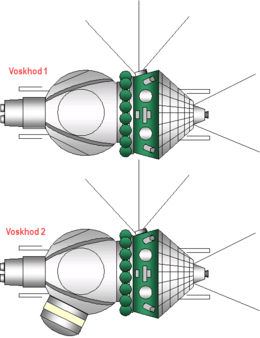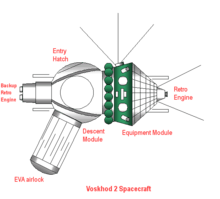Voskhod (spacecraft)
 Voskhod 1 and 2 spacecraft | |
| Manufacturer | OKB-1 |
|---|---|
| Designer | Sergei Korolev |
| Country of origin | Soviet Union |
| Operator | OKB-1 (Now RKK Energia) |
| Applications | Manned spaceflight |
| Specifications | |
| Spacecraft type |
Vostok-3KV Vostok-3KD |
| Crew capacity | 2 |
| Regime | Low Earth |
| Production | |
| Status | Retired |
| Built | 5+ |
| Launched | 5 |
| Retired | 5 |
| First launch | 1964 |
| Last launch | 1965 |
| Related spacecraft | |
| Derived from | Vostok |
| Derivatives | Bion |
The Voskhod (Russian: Восход, "Sunrise") was a spacecraft built by the Soviet Union's space program for human spaceflight as part of the Voskhod programme. It was a development of and a follow-on to the Vostok spacecraft. Voskhod 1 was used for a three manned flight whereas Voskhod 2 had a crew of two. They consisted of a spherical descent module (diameter 2.3 meters), which housed the cosmonauts, and instruments, and a conical equipment module (mass 2.27 tonnes, 2.25 m long, 2.43 m wide), which contained propellant and the engine system. Voskhod was superseded by the Soyuz spacecraft in 1967.
Design
The Voskhod spacecraft was, essentially, a Vostok spacecraft that had a backup solid fuel retro rocket added to the top of the descent module. The ejection seat was removed for more space and two or three crew couches were added to the interior at a 90-degree angle to that of the Vostok crew position. There was no provision for crew escape in the event of a launch or landing emergency.
Lack of space meant that the three crew members of Voskhod 1 did not wear space suits.[1] Both crew members wore spacesuits on the Voskhod 2 mission, as it involved an EVA and used an inflatable airlock. This allowed cosmonaut Aleksei Leonov to exit and re-enter the craft. It was needed because the vehicle's electrical and environmental systems were air-cooled, and complete capsule depressurization would lead to overheating. The airlock weighed 250 kg, was 700 mm in diameter, 770 mm high when collapsed for launch. When extended in orbit, it was 2.5 m long, had an internal diameter of 1.0 m and an external diameter of 1.2 m. The second crew member wore a spacesuit as a precaution against accidental descent module depressurization. The airlock was jettisoned after use.
The lack of ejection seats meant that the Voskhod crew would return to Earth inside their spacecraft unlike the Vostok cosmonauts who ejected and parachuted down separately. Because of this, a new landing system was developed, which added a small solid-fuel rocket to the parachute lines. It fired as the descent module neared touchdown, providing a softer landing.
A backup solid-fueled retrorocket was added to the top of the descent module in the event that the main retrorocket failed. This had not been necessary on Vostok as the orbit was low enough that the spacecraft would decay in ten days if the retrorocket failed, there being enough onboard consumables to sustain the cosmonaut that long. In any case, the Blok E equipped R-7 booster lacked sufficient lift capacity for a backup retrorocket. Since Voskhod was well below the maximum lift capacity of the larger Blok I equipped R-7, it would be put into a quite high orbit and not decay in ten days.
Voskhod utilized the 11A57 booster, essentially the Molniya 8K78L with the Blok L stage removed to create a medium lift LEO launcher, and later the launch vehicle for the Soyuz program.
The spacecraft notably lacked any launch escape system, meaning that the crew would not survive a booster failure that occurred in the first 2-1/2 minutes of launch (after payload shroud jettison, the descent module could simply be detached). Although work had begun on a LES in 1962, it was not ready yet and so the engineers and cosmonauts simply had to gamble that the booster functioned properly during ascent, as by 1964, the R-7's success rate was improving but still not perfect.
Vostok 3KV (1964)
Also known as Voskhod. Adaptation of the Vostok spacecraft for three cosmonauts. This version flew twice, on 6 October 1964 unmanned (as Kosmos 47) and on 12 October 1964 manned as Voskhod 1.
Basic data
- Crew size: 3 (without spacesuits)
- Endurance: 14.0 days
- Overall length: 5.0 m
- Maximum diameter: 2.4 m
- Total mass: 5,682 kg
- Propellant mass: 362 kg
- RCS total impulse: not available
- Primary engine thrust: 15.83 kN
- Main engine propellants: nitrous oxide/amine
- Total spacecraft delta v: 215 m/s
- Power: batteries; 24.0 kW total
Reentry module
- Crew size: 3
- Diameter: 2.3 m (sphere)
- Total mass: 2,900 kg
- Attitude control: none
- Environment: oxygen + nitrogen at 1 atm
- Controls: as Vostok 3KA
- Navigation indicator: Globus IMP navigation instrument version 3[2]
- Landing system: Sphere made ballistic reentry, with shield side seeking correct orientation by virtue of the center of gravity being aft of the center of the sphere.
- Parachutes: single with suspended retrorocket package for soft landing. Crew stayed within the capsule.
Equipment module
- Length: 2.3 m
- Maximum diameter: 2.4 m
- Total mass: 2,300 kg
- Propellant mass: 275 kg
- Reaction control system
- thrusters: not available
- Thrusters pressure: 59 PSI (4 bars)
- Propellant media: Cold gas (nitrogen) at 2200 PSI (150 bar)
- Propellants storage: 20 kg stored in 12 pressure bottles (5 + 5 + 2 for first, second and reserve)
- specific impulse: not available
- total impulse: not available
- Retro-rockets
- thrust: 15.83 kN
- propellant: nitrous oxide/amine
- specific impulse: 266 s
- delta v: 155 m/s
- Power: batteries; 24.0 kW total, 0.20 kW average
Auxiliary retrorocket module
Length: 0.6 m Maximum diameter: 0.3 m Total mass: 143 kg Propellant mass: 87 kg Thrust: 117.7 kN Propellant: solid Specific impulse: 224 s Delta v: 60 m/s
Voskhod 3KD (1965)
This version flew twice, on 22 February 1965 unmanned (as Kosmos 57) and on 18 March 1965 manned as the Voskhod 2 spacecraft.
Reentry Module
Reentry Module: Voskhod SA. Also known as: Spuskaemiy apparat - Sharik (sphere).
- Crew Size: 2
- Length: 2.3 m
- Diameter: 2.3 m
- Mass: 2,900 kg
- Heat Shield Mass: 837 kg
- Recovery equipment: 151 kg
- Parachute deploys at 2.5 km altitude
- Crew lands in spacecraft. Touchdown rocket softens landing.
- Ballistic reentry acceleration: 8 g (78 m/s²)
Equipment Module
Equipment Module: Voskhod PA. Also known as: Priborniy otsek.
- Length: 2.25 m
- Diameter: 2.43 m
- Mass: 2,300 kg
- Equipment in pressurized compartment
- RCS Propellants: Cold gas (nitrogen)
- RCS Propellants: 20 kg
- Main Engine (TDU): 397 kg
- Main Engine Thrust: 15.83 kN
- Main Engine Propellants: Nitrous oxide/amine
- Main Engine Propellant Mass: 275 kg
- Main Engine Isp: 266 s (2.61 kN·s/kg)
- Main Engine Burn Time: 1 minute (typical retro burn = 42 seconds)
- Spacecraft delta v: 155 m/s
- Electrical System: Batteries
- Electric System: 0.20 average kW
- Electric System: 24.0 kW h
Auxiliary Retrorocket Module
Auxiliary Retrorocket Module: Voskhod KDU. Also known as: Engine unit
- Length: 0.60 m
- Diameter: 0.25 m
- Mass: 143 kg
- Engine Thrust: 118 kN
- Engine Propellants: Solid
- Propellant Mass: 87 kg
- Engine Isp: 224 s (2.20 kN·s/kg)
- Spacecraft delta v: 60 m/s
General data
- Total Mass:5,682 kg
- Total Length: 5.0 m
- Endurance: Supplies for 14 days in orbit
- Launch Vehicle: Voskhod 11A57
- Typical orbit: 163 km x 591 km, 64.8 inclinaton
See also
References
- ↑ Siddiqi 2000, p. 423.
- ↑ Collins, Amy Kyra. "Globe Device - IMP (глобус)". The Panels of the Spacecraft "Vostok".
Bibliography
- Siddiqi, Asif A. (2000). Challenge To Apollo: The Soviet Union and the Space Race, 1945-1974 (PDF). USA: NASA. ISBN 1780393016.
